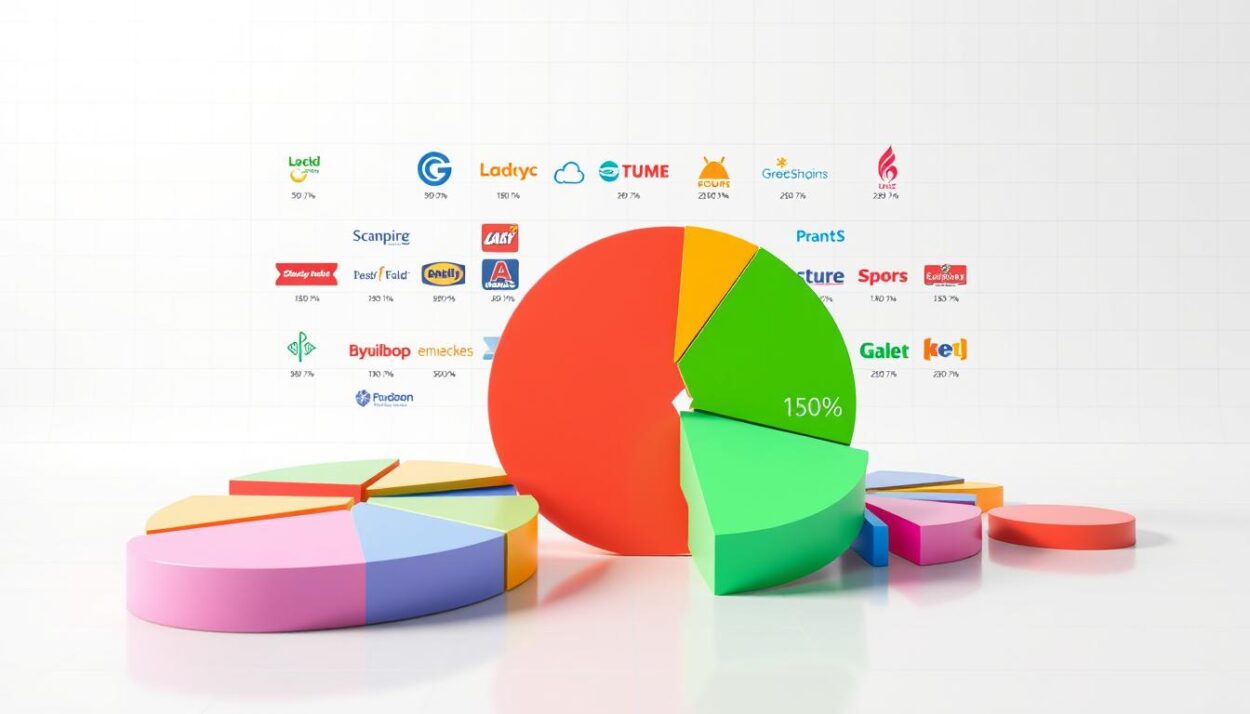Did you know that the grocery retail market in the United States is projected to reach approximately $864 billion by 2025? This remarkable figure highlights the critical role that grocery store chains play in the American economy. As of June 2024, there were 305,156 grocery stores across the nation, ranging from expansive warehouse hypermarkets to intimate specialty shops. The evolution from family-owned operations to large diversified chains illustrates the shifting dynamics of consumer preferences and shopping habits. This report will provide an in-depth analysis of the 17 largest grocery chains in the US, examining their operational strategies, market share, and the key trends shaping their success in the increasingly competitive landscape.
Key Takeaways
- The grocery retail market is set to reach $864 billion by 2025.
- As of June 2024, there are over 305,000 grocery stores in the US.
- The market is experiencing a compound annual growth rate (CAGR) of 4.06% until 2029.
- Diverse store formats are shaping the grocery shopping experience.
- This report analyzes the largest grocery chains and their market positions.
Overview of the US Grocery Industry
The US grocery industry is experiencing significant evolution and growth, largely driven by changing consumer behaviors and market dynamics. With the food retail market projected to hit $864 billion by 2025, understanding these trends becomes essential for stakeholders navigating this competitive landscape. A comprehensive grocery market analysis reveals various factors contributing to this growth, including demographic shifts that generate an increasing demand for diverse and ethnic food options.
Market Size and Growth Projections
Various reports indicate a robust expansion in the grocery sector, underlining the industry’s resilience amid economic fluctuations. This sector is influenced by consumer preferences, making detailed grocery market analysis crucial for identifying patterns and forecasting future trends. As the market evolves, grocery chains are adapting to meet customer needs, implementing strategies that prioritize convenience and variety in product offerings.
Types of Grocery Store Chains
The US grocery industry encompasses a variety of store formats, each catering to distinct customer segments:
- Supermarkets: These large-scale operations offer a comprehensive array of products, including groceries, household goods, and personal care items.
- Specialty food stores: Focusing on unique market niches, these stores typically specialize in organic or gourmet products, attracting specific consumer demographics.
- Convenience stores: Providing quick access to essential items, these stores appeal to busy consumers looking for on-the-go solutions.
- Warehouse clubs and discount grocers: Retailers like Costco and Aldi dominate this segment by offering bulk purchases at lower prices, targeting budget-conscious shoppers.
- Online grocery retailers: E-commerce platforms, such as Amazon Fresh, continue to reshape the landscape by enhancing shopping experiences with delivery and pick-up options.
This diverse array of grocery store chains reflects the industry’s adaptability in response to consumer demands and market forces.
17 Largest Grocery Chains in US [Report 2025]
The competitive landscape of the grocery industry offers insights into the foremost players shaping the market. A detailed examination of supermarket rankings reveals the top grocery retailers dominating with their extensive networks of stores. The report for 2025 highlights not only the leaders in store count but also their influence on grocery market share across the United States.
Ranking of the Top Chains
Aldi, Albertsons, and Publix emerge as the front-runners in the grocery retail sector. With 2,489, 2,308, and 1,448 locations respectively, these chains amass a significant share of the grocery market. Their expansion strategies and store offerings resonate with a growing consumer base, reinforcing their positions in supermarket rankings. Following them closely are Kroger and Safeway, which maintain a robust presence in multiple states.
Market Share Distribution
The consolidation within the grocery market accentuates the dominance of these chains. A multi-faceted analysis of the market share distribution illustrates that the largest grocery retailers not only maintain substantial bargaining power but also entice customers through brand loyalty and diversified product offerings. This intricate web of influence shapes buying patterns and consumer preferences.

Key Trends Influencing the Grocery Market
The grocery market is undergoing significant transformations driven by various trends shaping consumer behaviors and industry strategies. These evolving dynamics reflect the increasing challenges within the grocery industry, particularly influenced by inflation and technological advancements. Retailers are compelled to adapt to meet shifting demands and enhance customer satisfaction.
Inflation and Consumer Preferences
Inflationary pressures are prompting consumers to prioritize value in their grocery purchases. With supermarket food prices rising steeply, many shoppers are gravitating towards discount retailers and private-label brands. This shift underscores how grocery industry trends influence purchasing decisions, driving competition among market players to provide more cost-effective options. Supermarkets are expanding their offerings, focusing on budget-friendly products to retain customer loyalty and attract price-sensitive buyers. As this trend continues, grocery market competition will intensify, compelling retailers to innovate and differentiate themselves.
Technological Advancements
Innovations are redefining how consumers interact with grocery retailers, enabling a more personalized shopping experience. The integration of artificial intelligence has transformed inventory management, allowing for better product availability and tailored marketing strategies. For instance, platforms like Instacart employ AI to offer recommendations based on individual preferences, enhancing user engagement. This emphasis on technology reflects a broader trend that acknowledges the growing importance of online grocery shopping, especially as consumers navigate inflationary challenges. As convenience increasingly drives consumer choices, the role of e-commerce in the grocery sector is expected to expand significantly.
Regional Dynamics in the US Grocery Market
Understanding regional dynamics plays a vital role in navigating the competitive landscape of the U.S. grocery market. Variations in demographics, culture, and consumer behavior necessitate tailored strategies from major grocery chains. Companies need to observe and adapt to these regional differences to remain competitive. As grocery store competition intensifies, businesses find strategic adaptations essential for growth and sustainability.
Understanding Regional Differences
Regional dynamics significantly influence consumer preferences, which can vary widely across the United States. For example, coastal areas often prioritize fresh seafood and organic products, while midwestern regions may lean towards hearty, less perishable goods. Factors like local traditions, climate, and even economic conditions shape the types of products favored by consumers. Grocery chains like Kroger and Publix analyze these local tastes to optimize inventory and marketing strategies, ensuring alignment with consumer demands.
Expansion Strategies of Major Chains
As grocery chains seek to expand their market share, effective strategies often involve targeting untapped regions. For instance, Aldi’s plan to add 800 stores by 2028 illustrates a proactive approach to geographical growth. This expansion allows Aldi to capitalize on changing consumer preferences and regional demands. Other chains, such as Walmart and Costco, employ similar regional dynamics in their expansion efforts, focusing on customer engagement through localized offerings.
| Grocery Chain | Expansion Goals | Key Regions Targeted |
|---|---|---|
| Aldi | 800 new stores by 2028 | Western US, Southeast |
| Kroger | New locations in urban areas | Coastal cities |
| Walmart | Expand Supercenters | Suburban and rural areas |

Conclusion
The analysis of the grocery sector indicates a competitive landscape defined by rapid evolution and change. The 17 largest grocery chains in the US, as highlighted in this report, are poised to navigate through various challenges such as inflationary pressures, the emergence of technological innovations, and regional market disparities. Their ability to adapt will be instrumental in maintaining relevance and enhancing market share moving into 2025 and beyond.
Furthermore, this grocery market analysis reveals the profound influence of consumer behavior and preferences on the strategic directions of these chains. Factors such as socio-economic conditions and shifting demographics are critical elements that will continue to shape grocery store strategies, prompting innovations and targeted expansion in response to evolving market demands.
Ultimately, this report not only underscores the contributions of the largest grocery chains but also highlights the interconnected trends that currently define the grocery landscape in the United States. Understanding these dynamics is essential for stakeholders looking to navigate the complexities of the industry effectively.

![17 Largest Grocery Chains in US [Report 2025]](https://www.southwestjournal.com/wp-content/uploads/2025/05/17-Largest-Grocery-Chains-in-US-Report-2025.jpeg)












